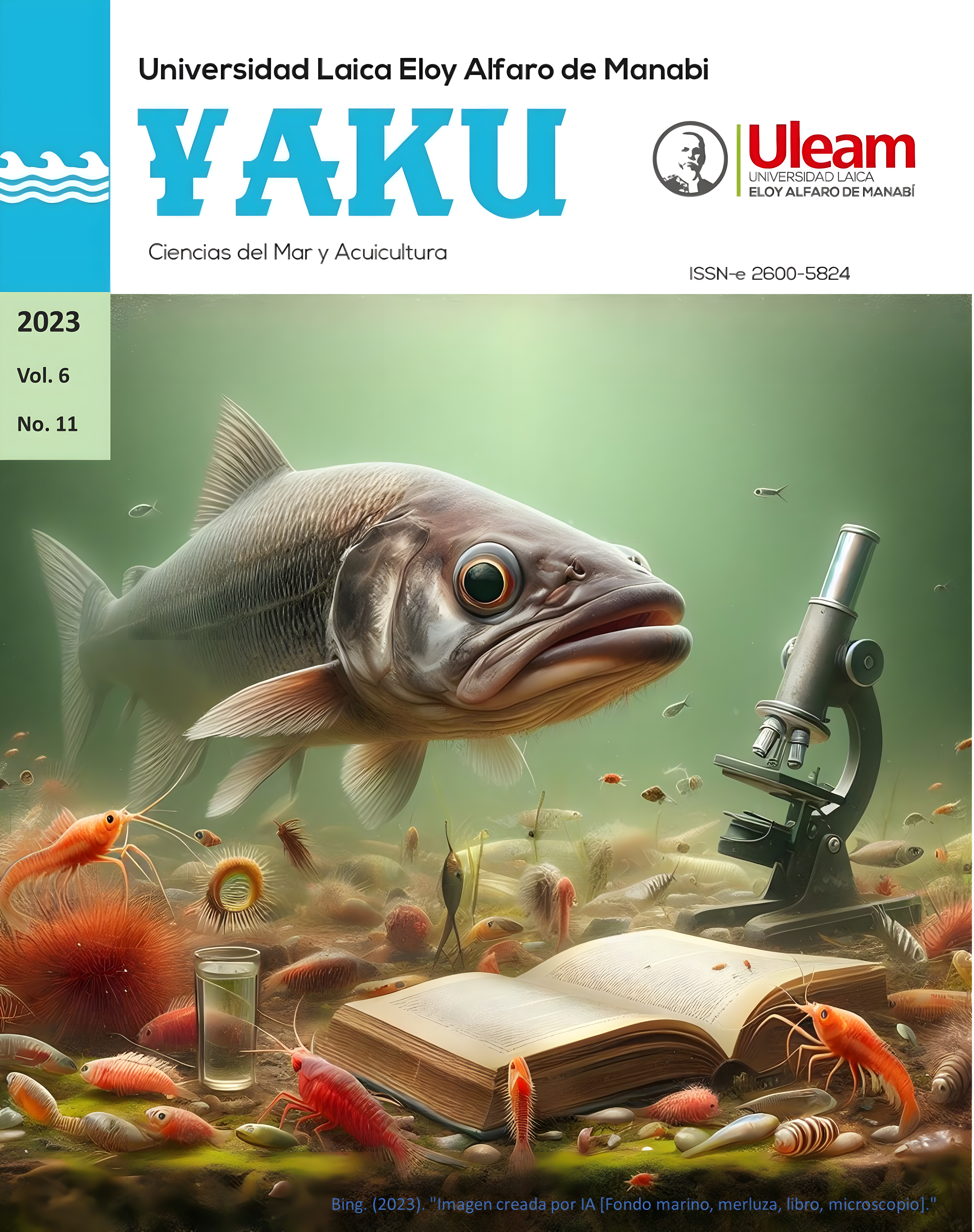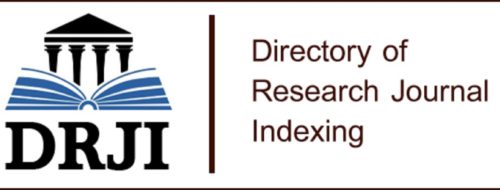Temporal variation in size and sexual maturity of common hake (Merluccius gayi, guichenot, 1848) from deep longline fishing in ecuadorian waters
DOI:
https://doi.org/10.56124/yaku.v6i11.543Keywords:
Size distribution, Sexual maturity, Bottom Longline, Aggregation zones, Common hake, Santa Elena Península, Artisanal FishingAbstract
The hake fishery in Ecuador has experienced a significant increase since 2013, becoming an alternative to shrimp fishing. This fish is primarily exported to Spain, one of the largest consumers of hake worldwide. The trawl fleet operates mainly in the Posorja port, and it is estimated that 2,133,985 kg of hake were landed in 2019. Therefore, this study focuses on analyzing temporal changes in the size structure and sexual maturity of common hake (Merluccius gayi) caught using bottom longline fishing gear in Ecuadorian waters. Biological data such as total length, sex, and sexual maturity of the hake resource landed in the artisanal fishing port of Santa Rosa de Salinas, Santa Elena, were collected between 2013 and 2016. It was determined that the sex ratio was skewed towards females, and significant differences in sizes between sexes were observed, with females being larger. Regarding sexual maturity, five gonadal stages were identified in females and three in males. The average size at sexual maturity for females was determined to be LT50=48.53 cm, while for males, it was LT50=31.22 cm. Significant differences were evident between the sizes of sexual maturity in females and males, with females being 35% larger at the time of maturity compared to males.
Downloads
References
Canal Loayza, R. (1989). Evaluación de la capacidad y condición reproductiva de la merluza (Merluccius gayi peruanus).
Cerna, J. F., & Oyarzún, C. (1998). Talla de primera madurez sexual y fecundidad parcial de la merluza común (Merluccius gayi, Guichenot 1848) del área de la pesquería industrial de la zona de Talcahuano, Chile. Investigaciones marinas, 26, 31-40.
Coello, D., Herrera, M., Castro, R., Medina, C., & Salcedo, J. (2017). Caracterización de la pesquería artesanal de merluza (merluccius GAYI) en la caleta pesquera de Santa Rosa (provincia de Santa Elena). Revista Científica Ciencias Naturales y Ambientales, 11(1), 12-21.
Chicaiza, D., García-Sáenz, R., & Mendívez, W. (2009). La pesquería de arrastre del camarón pomada (Protrachypene precipua) en la zona de Posorja-Ecuador durante 2008.
Chirichigno Fonseca, N., & Velez Dieguez, J. (1998). Clave para identificar los peces marinos del Perú.
Elisio, M., Rodrigues, K., Leonarduzzi, E., Somoza, G. M., & Macchi, G. J. (2021). Avances en eco-fisiología reproductiva de la merluza (Merluccius hubbsi): Influencia del ambiente sobre la ovulación y formación de agregaciones reproductivas.
Garcia, M., Gilces, I., Lavayen, F., Daza, C., Bermudez, C., Avila, E., & Cevallos, A. (2014). Pesquería del recurso merluza (Merluccius gayi) en el Ecuador Continental 2013. Informe Viceministerio de acuacultura y pesca.
González, N. (2010). La pesquería de peces pelágicos pequeños en Ecuador durante 2009.
Guayanay Gusqui, D. A. (2022). Análisis de aspectos biológicos de Merlucius gayi Guichenot, 1848, capturados por la flota pesquera de Ecuador, durante 2017–2021 La Libertad: Universidad Estatal Península de Santa Elena, 2022].
Hanusz, Z., & Tarasińska, J. (2015). Normalization of the Kolmogorov–Smirnov and Shapiro–Wilk tests of normality. Biometrical Letters, 52(2), 85-93.
Hernández-Urcera, J., Lago-Rouco, M. J., Iglesias-Estévez, J., Sánchez-Conde, F. J., & Cal, R. (2009). Obtención de un stock de reproductores de merluza europea, Merluccius merluccius L.: Captura, transporte y estabulación. Foro dos Recursos Mariños e da Acuicultura das Rías Galegas, 543-548.
Hunter, J., Lo, N. C., & Leong, R. J. (1985). Batch fecundity in multiple spawning fishes. NOAA Technical Report NMFS, 36, 67-77.
Jurado, V., Gilbert, G., Ponce, G., & Solís, K. (2019). Interacción entre aves marinas, tortugas y mamíferos marinos en la pesquería con red de cerco en la costa continental de Ecuador durante junio-octubre de 2019. Instituto Público de Investigación de Acuicultura y Pesca.
Lloris, D., & Matallanas, J. (2003). Merluzas del mundo (Familia Merlucciidae): Catálogo comentado e ilustrado de las merluzas conocidas. Food & Agriculture Org.
McKight, P. E., & Najab, J. (2010). Kruskal‐wallis test. The corsini encyclopedia of psychology, 1-1.
Morales Tejeda, G. (2021). Aspectos pesqueros y biológicos de la merluza (Merluccius gayi peruanus) capturada por la pesca artesanal en dos caletas de Piura.
Ogle, D., & Ogle, M. D. (2017). Package ‘FSA’. Cran Repos, 1-206.
Ogle, D. H., Wheeler, P., & Dinno, A. (2017). FSA: fisheries stock analysis. R package version 0.8, 17, 636.
Oliva, J., Carbajal, W., & Tresierra, A. (1982). Reproducción e histología de gónadas en peces.
Pérez, M. Í. P., Gil, M. D. G., & Lafuente, M. M. V. (2014). Modelo multiespecífico para la merluza y el lirio en aguas españolas. Documentos de traballo do Departamento de Economía Aplicada (3), 1.
Pilay, D., & Torres, A. (2018). Pesqueria artesanal y aspectos reproductivos de merluza Merluccius Gayi en el puerto pesquero de Anconcito en la provincia de Santa Elena durante el 2014. Revista Científica Ciencias Naturales y Ambientales, 12(2), 75-82.
R Core Team, R., & Team, R. C. (2021). R: a language and environment for statistical computing. R Foundation for Statistical Computing; 2020. In.
Razali, N. M., & Wah, Y. B. (2011). Power comparisons of shapiro-wilk, kolmogorov-smirnov, lilliefors and anderson-darling tests. Journal of statistical modeling and analytics, 2(1), 21-33.
Smart, J. (2019). AquaticLifeHistory: Fisheries life history analysis using contemporary methods. R package, vers. 0.0, 9000.
Toledo Delgado, J. W. (2017). Aspectos reproductivos de la Merluza (Merluccius gayi) en la estación lluviosa en el Golfo de Guayaquil.
Wickham, H. (2011). ggplot2. Wiley interdisciplinary reviews: computational statistics, 3(2), 180-185.
Wickham, H., Averick, M., Bryan, J., Chang, W., McGowan, L. D. A., François, R., Grolemund, G., Hayes, A., Henry, L., & Hester, J. (2019). Welcome to the Tidyverse. Journal of open source software, 4(43), 1686.
Wickham, H., Chang, W., & Wickham, M. H. (2016). Package ‘ggplot2’. Create elegant data visualisations using the grammar of graphics. Version, 2(1), 1-189
Published
How to Cite
Issue
Section
License
Copyright (c) 2023 Revista de Ciencias del Mar y Acuicultura YAKU. ISSN: 2600-5824.

This work is licensed under a Creative Commons Attribution-NonCommercial-ShareAlike 4.0 International License.


1.jpg)













